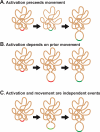Chromatin organization and transcriptional regulation
- PMID: 23270812
- PMCID: PMC3612554
- DOI: 10.1016/j.gde.2012.11.006
Chromatin organization and transcriptional regulation
Abstract
Cell type specific transcriptional regulation must be adhered to in order to maintain cell identity throughout the lifetime of an organism, yet it must be flexible enough to allow for responses to endogenous and exogenous stimuli. This regulation is mediated not only by molecular factors (e.g. cell type specific transcription factors, histone and DNA modifications), but also on the level of chromatin and genome organization. In this review we focus on recent findings that have contributed to our understanding of higher order chromatin structure and genome organization within the nucleus. We highlight new findings on the dynamic positioning of genes relative to each other, as well as to their chromosome territory and the nuclear lamina, and how the position of genes correlates with their transcriptional activity.
Copyright © 2012 Elsevier Ltd. All rights reserved.
Figures


References
-
- Flemming W. Zellsubstanz, Kern und Zelltheilung. F. C. W. Vogel; Leipzig: 1882.
-
- Felsenfeld G, Groudine M. Controlling the double helix. Nature. 2003;421:448–453. - PubMed
-
- Olins AL, Olins DE. Spheroid chromatin units (v bodies) Science. 1974;183:330–332. - PubMed
-
- Woodcock CF. Ultrastructure of inactive chromatin. J. Cell. Biol. 1973;59:368a.
Publication types
MeSH terms
Substances
Grants and funding
LinkOut - more resources
Full Text Sources
Other Literature Sources

